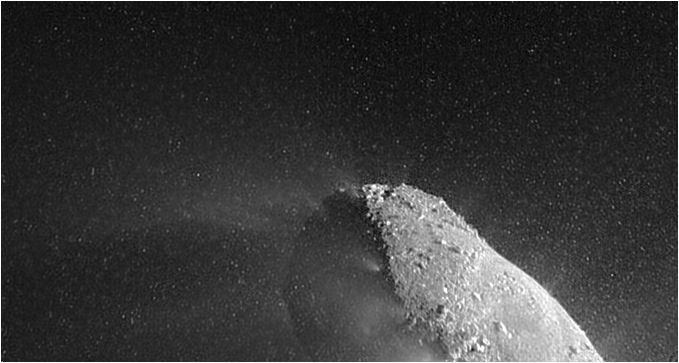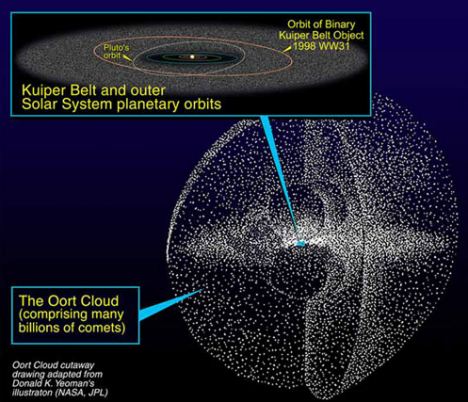
© Deep Impact, NASAThis contrast-enhanced image obtained during Deep Impact's Nov. 4th flyby of Comet Hartley 2 reveals a cloud of icy particles surrounding the comet's active nucleus.
NASA has just issued a travel advisory for spacecraft: Watch out for Comet Hartley 2, it is experiencing a significant winter snowstorm.
Deep Impact photographed the unexpected tempest when it flew past the comet's nucleus on Nov. 4th at a distance of only 700 km (435 miles). At first, researchers only noticed the comet's hyperactive jets. The icy nucleus is studded with them, flamboyantly spewing carbon dioxide from dozens of sites. A closer look revealed an even greater marvel, however. The space around the comet's core is glistening with chunks of ice and snow, some of them possibly as large as a basketball.
"We've never seen anything like this before," says University of Maryland professor Mike A'Hearn, principal investigator of Deep Impact's EPOXI mission. "It really took us by surprise."
Before the flyby of Hartley 2, international spacecraft visited four other comet cores - Halley, Borrelly, Wild 2, and Tempel 1. None was surrounded by "comet snow." Tempel 1 is particularly telling because Deep Impact itself performed the flyby. The very same high resolution, high dynamic range cameras that recorded snow-chunks swirling around Hartley 2 did not detect anything similar around Tempel 1.
"This is a genuinely new phenomenon," says science team member Jessica Sunshine of the University of Maryland. "Comet Hartley 2 is not like the other comets we've visited."




Comment: Finally, some mainstream verification of what Sott.net has been saying for years is coming through the information blackout. In February media outlets carried reports that a swarm of comet debris may have caused the 'Dark Ages' circa 500 AD. Bill Napier, as well as Victor Clube, deserve major recognition for their dedication in putting many of the puzzle pieces together. The Cycle of Cosmic Catastrophes by Firestone, West and Warwick-Smith is the seminal book on this cometary bombardment, the Younger Dryas Impact Event, at the end of the last Ice Age.
Besides older comets that break up and leave debris trails through which the Earth periodically passes, Laura Knight-Jadczyk's tireless research has led us to consider the cyclical mechanism by which comets from the Oort Cloud surrounding the outer solar system are knocked into the inner solar system by the return of the Sun's dark star companion, 'Nemesis.'
We've been observing the steady increase in the number of fireball sightings, the cooling of the upper atmosphere, strange cloud formations and recent comet impacts on other planets in our solar system. Taken with research which reveals that our environment is constantly affected by interaction with comet dust (sometimes laden with larger fragments) and cosmic radiation, we've deduced that our Big Blue Marble is once again on the threshold of encountering a cosmic storm. In fact, it's overdue for the Perfect Storm as several cycles return together.
For more in-depth reading, see Laura Knight-Jadzyck's article Meteorites, Asteroids, and Comets: Damages, Disasters, Injuries, Deaths, and Very Close Calls.
Something Wicked This Way Comes, a Sott.net production: